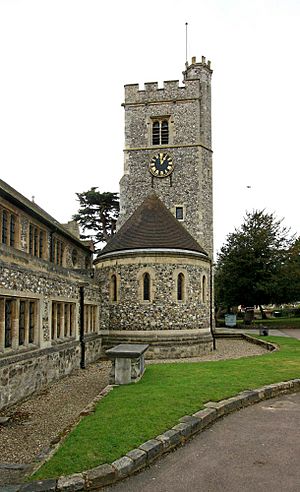Bromley Parish Church Memorial facts for kids

Bromley Parish Church Memorial
|
|
| Coordinates | 51°24′17.92″N 00°00′45.58″E / 51.4049778°N 0.0126611°E |
|---|---|
| Location | Bromley, Greater London, England |
| Designer | Sydney March |
| Type | War memorial |
| Material | Portland stone |
| Height | 5 metres |
| Completion date | 1921 |
| Opening date | 20 March 1921 |
| Dedicated to | Fallen parishioners of World War I |
The Bromley Parish Church Memorial is a special monument that remembers people from the local church and area who sadly died in World War I. It was created by a talented British sculptor named Sydney March, who came from a family of artists. This memorial helps us remember their bravery and sacrifice.
Contents
What Does the Memorial Look Like?
The Bromley Parish Church Memorial stands in the churchyard of Saint Peter and Saint Paul. This church is also known as Bromley Parish Church. It is located on Church Road in Bromley, Greater London, England.
The main part of the memorial is a tall memorial cross. It is made from Portland stone, which is a special type of rock. This stone comes from the Isle of Portland in the English Channel. The cross is designed in an old style called Gothic.
The memorial cross is about five meters tall. It has four figures carved into it. These figures represent Saint Michael, Saint George, Victory, and Peace. At the bottom of the cross, there are some important words. They say: "In memory of the Men from this Church and Parish who gave their lives in the War of 1914–1919." Another message adds: "Make them to be numbered with the Saints in glory everlasting." It also mentions that "Their names are recorded on a tablet in the Church." The cross is placed in a pretty rose garden, surrounded by a tall hedge.
When Was It Opened?
The Bromley Parish Church Memorial honors the people from St. Peter and St. Paul who died in World War I. It was officially revealed on March 20, 1921. Major General Sir John Longley unveiled the memorial. He was a military leader who served in both World War I and World War II.
After the unveiling, the Bishop of Rochester, Dr. John Reginald Harmer, dedicated the memorial. He was an important church leader. After the ceremony outside, everyone went inside the church. There, a bronze plaque was also revealed. This plaque had the names of all the people who died. A church service followed, led by the Vicar, Reverend J. K. Wilson.
Damage and Rebuilding
During World War II, many churches were damaged by bombs. On April 16, 1941, Bromley Parish Church was almost completely destroyed. Only its old 14th-century tower survived the bombing. The bronze plaque inside the church, which was part of the memorial, was lost. However, the memorial cross in the churchyard was not damaged.
After the war, Bromley Parish Church was rebuilt. Princess Elizabeth, who later became Queen Elizabeth II, laid the first stone for the new church on October 13, 1949. The building of the new church was finished on December 14, 1957. The new church bells were made using some metal from the original bells.
Who Was the Sculptor?
Both the memorial cross and the bronze plaque were designed by a British sculptor named Sydney March. He was born in 1876 in Stoneferry, England. Sydney was one of nine children, and eight of them became artists!
Sydney March showed his art many times at a famous art show called The Exhibition of the Royal Academy of Arts. He and his brothers and sisters had their own art studios at their family home. Sydney was a very busy artist. He mostly created war memorials and sculptures of important people, like kings and queens.
Sydney and his siblings finished the National War Memorial of Canada. They did this after their brother, Vernon March, who was also a sculptor, passed away in 1930. Sydney March also created other famous monuments. These include the Royal Inniskilling Fusiliers South African War Memorial in Northern Ireland. He also made the United Empire Loyalist Monument in Canada and the Lancaster Monument in England. Some of his smaller works include busts (sculptures of heads and shoulders) of King Edward VII and Cecil Rhodes. These can be seen in London's National Portrait Gallery.


